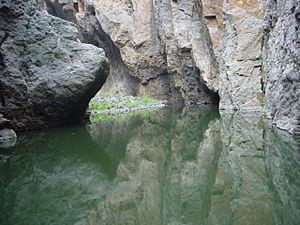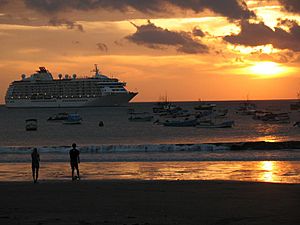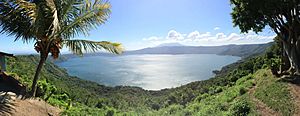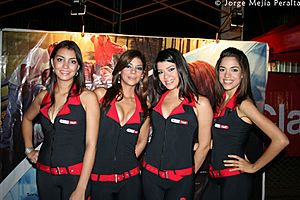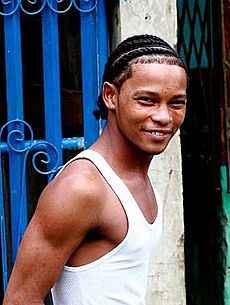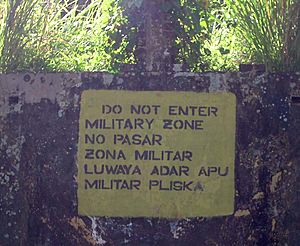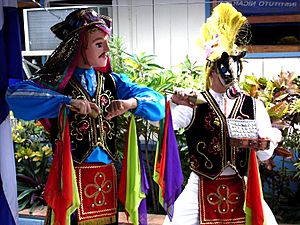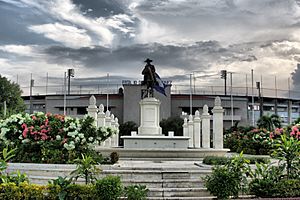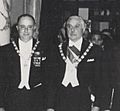Nicaragua facts for kids
Quick facts for kids
Republic of Nicaragua
República de Nicaragua (Spanish)
|
|
|---|---|
|
|
|
|
Anthem: Salve a ti, Nicaragua (Spanish)
"Hail to Thee, Nicaragua" |
|
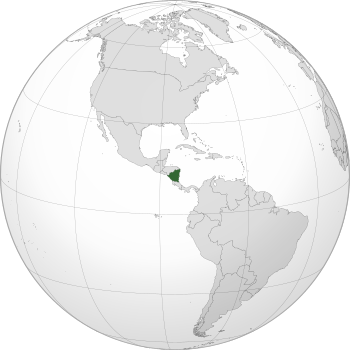 |
|
| Capital and largest city
|
Managua 12°6′N 86°14′W / 12.100°N 86.233°W |
| Official languages | Spanish |
| Recognised regional languages |
|
| Ethnic groups
(2023)
|
|
| Religion
(2015)
|
|
| Demonym(s) |
|
| Government | Unitary diarchic presidential socialist republic under an authoritarian dictatorship |
| Legislature | National Assembly |
| Independence from Spain, Mexico and the Federal Republic of Central America | |
|
• Declared
|
15 September 1821 |
|
• Recognized
|
25 July 1850 |
|
• From the First Mexican Empire
|
1 July 1823 |
|
• From the Federal Republic of Central America
|
31 May 1838 |
|
• Nicaraguan Revolution
|
19 July 1979 |
|
• Current constitution
|
9 January 1987 |
| Area | |
|
• Total
|
130,375 km2 (50,338 sq mi) (96th) |
|
• Water (%)
|
7.14 |
| Population | |
|
• 2023 estimate
|
|
|
• Density
|
51/km2 (132.1/sq mi) (155th) |
| GDP (PPP) | 2024 estimate |
|
• Total
|
|
|
• Per capita
|
|
| GDP (nominal) | 2024 estimate |
|
• Total
|
|
|
• Per capita
|
|
| Gini (2014) | 46.2 high |
| HDI (2022) | medium · 130th |
| Currency | Córdoba (NIO) |
| Time zone | UTC−6 (CST) |
| Driving side | right |
| Calling code | +505 |
| ISO 3166 code | NI |
| Internet TLD | .ni |
Nicaragua is a country located in Central America. Its official name is the Republic of Nicaragua (Spanish: República de Nicaragua). It covers an area of about 129,494 square kilometres. With over 7 million people as of 2024, it is the third-most populated country in Central America.
Nicaragua shares borders with Honduras to the north and Costa Rica to the south. The capital city is Managua. Managua is the third-largest city in Central America. It is also the biggest city in Nicaragua. Almost a quarter of the country's population lives there.
Nicaragua's population is very diverse. It includes native tribes from the Miskito Coast. There are also people of European, African, and Asian backgrounds. The main language spoken is Spanish. However, some native tribes on the eastern coast speak their own languages. These include Miskito, Sumo, and Rama. Some people also speak English Creole. This mix of cultures has created rich art and literature. Famous Nicaraguan writers include Rubén Darío and Ernesto Cardenal.
Nicaragua has many different plants and animals. It also has a warm tropical climate and active volcanoes. These features make it a popular place for tourists to visit.
Contents
Nicaragua's Story
A Look at the Past
Nicaragua was first home to many different native cultures. In the 1500s, the Spanish Empire took control of the region. Nicaragua became independent from Spain in 1821.
The area known as the Mosquito Coast had a different history. The English settled there in the 1600s. It later became a British territory. In 1860, it became an independent area within Nicaragua. Part of it was given to Honduras in 1960.
Since gaining independence, Nicaragua has faced many challenges. These include times of political trouble and dictatorships. There were also periods of foreign occupation and money problems. Important events include the Nicaraguan Revolution in the 1960s and 1970s. The Contra War happened in the 1980s.
Land and Weather
Exploring Nicaragua's Geography
Nicaragua covers about 130,967 square kilometers of land. It has three main geographic areas. These are the Pacific lowlands, the Amerrisque Mountains (central highlands), and the Mosquito Coast (Caribbean lowlands).
The low plains on the Atlantic Coast can be up to 97 kilometers wide. People have used their natural resources for a long time.
On Nicaragua's Pacific side are two large freshwater lakes. These are Lake Managua and Lake Nicaragua. Around these lakes are fertile plains. The soil there is rich from ash from nearby volcanoes. Nicaragua has many unique ecosystems. This makes it a place with high biodiversity.
Almost one-fifth of Nicaragua is protected land. This includes national parks and nature reserves. Nicaragua is located where the Caribbean Plate and the Cocos Plate meet. This causes a lot of tectonic activity. Because of this, Nicaragua has many volcanoes. Most of them are part of the Central America Volcanic Arc.
Pacific Lowlands: Lakes and Volcanoes
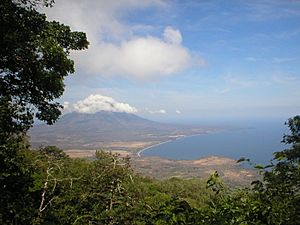
In western Nicaragua, these lowlands are wide, hot, and fertile. Many large volcanoes dot this plain. These include Mombacho near Granada and Momotombo near León. This lowland area stretches from the Gulf of Fonseca to the border with Costa Rica.
Lake Nicaragua is the largest freshwater lake in Central America. It is the 20th largest in the world. It is home to rare freshwater sharks, like the Nicaraguan shark. More than half of Nicaragua's people live in the Pacific lowlands.
The eruptions of western Nicaragua's 40 volcanoes have sometimes caused damage. But they also make the land very fertile with layers of ash. The same geologic activity that creates volcanoes also causes strong earthquakes. Earthquakes happen often in the Pacific zone. They have nearly destroyed the capital city, Managua, more than once.
Most of the Pacific zone is a "hot land" (tierra caliente). Temperatures stay warm all year, usually between 29 and 32°C. A dry season lasts from November to April. Rains then start in May and continue until October. This brings 100 to 150 centimeters of rain. Good soil and a nice climate make western Nicaragua the country's economic and population center.
The southwestern shore of Lake Nicaragua is close to the Pacific Ocean. Because of this, people in the 1800s often suggested building a canal here. This canal would connect the lake and the San Juan River. Canal ideas have come up again in recent times.
The Pacific lowlands also have most of Nicaragua's old Spanish buildings. Cities like León and Granada have lots of colonial architecture. Granada was founded in 1524, making it one of the oldest colonial cities in the Americas.
North Central Highlands: Cooler Climates
Northern Nicaragua is a diverse region. It produces coffee, cattle, milk products, vegetables, wood, gold, and flowers. Its large forests and rivers are great for ecotourism.
The central highlands are less populated and developed. They are located in the north, between Lake Nicaragua and the Caribbean. This area is a "temperate land" (tierra templada). It has mild temperatures, with daily highs of 24 to 27°C.
This region has a longer and wetter rainy season than the Pacific lowlands. This can cause erosion on its steep slopes. The area generally has rough land, poor soil, and fewer people. However, the northwestern valleys are fertile and well-settled.
About a quarter of the country's farming happens here. Coffee is grown on the higher slopes. You can find Oaks, pines, moss, ferns, and orchids in the cloud forests. Birds like resplendent quetzals, goldfinches, hummingbirds, and toucanets live in these forests.
Caribbean Lowlands: Rainforests and Rivers
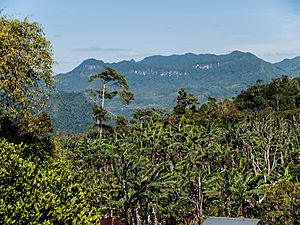
This large rainforest region has many big rivers. It is not very populated. This area makes up 57% of the country's land. It also has most of Nicaragua's mineral resources. While some resources have been used, much natural diversity remains. The Rio Coco is the largest river in Central America. It forms the border with Honduras.
Nicaragua's Bosawás Biosphere Reserve is in the Atlantic lowlands. It protects 1,800,000 acres of forest. This is almost 7% of the country's area. It is the largest rainforest north of the Amazon in Brazil.
The towns of Siuna, Rosita, and Bonanza are known as the "Mining Triangle." They are in the RAAN in the Caribbean lowlands. Bonanza still has an active gold mine. In Siuna and Rosita, people still pan for gold.
Nicaragua's tropical east coast is very different from the rest of the country. The climate is mostly tropical, with high temperatures and humidity. In the main city of Bluefields, English is widely spoken along with Spanish. The people here are more like those in other Caribbean ports.
Many birds can be seen here, including eagles, toucans, and macaws. Other animals include different kinds of monkeys, anteaters, and tapirs.
Amazing Animals and Plants
Nicaragua's Rich Biodiversity
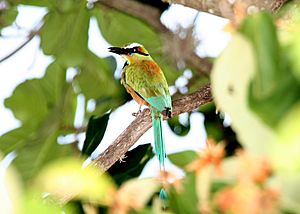
Nicaragua is home to a wide variety of plants and animals. Its location in the middle of the Americas helps it have great biodiversity. The weather and small changes in height also contribute. The country has 248 types of amphibians and reptiles. It also has 183 types of mammals, 705 bird species, and 640 fish species. About 5,796 types of plants have been found.
The largest forests are on the eastern side of the country. Rainforests are found in the Río San Juan Department and the autonomous regions of RAAN and RAAS. These forests hold the most biodiversity in the country. They are largely protected by the Indio Maíz Biological Reserve and the Bosawás Biosphere Reserve. Nicaragua's jungles cover about 2.4 million acres. They are seen as the "lungs" of Central America. They are the second-largest rainforests in the Americas.
There are 78 protected areas in Nicaragua. These cover over 22,000 square kilometers, about 17% of the land. They include wildlife refuges and nature reserves. These areas protect many different ecosystems. More than 1,400 animal species have been identified in Nicaragua. About 12,000 plant species have been identified, with an estimated 5,000 more yet to be classified.
The bull shark can live for a long time in fresh water. It is found in Lake Nicaragua and the San Juan River. It is often called the "Nicaragua shark." Nicaragua has recently stopped freshwater fishing for these sharks. This is to help their populations grow again.
How Nicaragua is Governed
Nicaragua has a presidential republic. This means the President of Nicaragua is both the head of state and head of government. The country has a multi-party system. The government has executive power. The national assembly has legislative power. The judiciary is the third branch of government.
In November 2024, the government made some changes to its constitution. These changes give more power to the "co-presidency." This allows them to work closely with other parts of the government. The changes also say that the country is a revolutionary socialist state. They also state that actions against the country's principles are not allowed. The government can limit public religious practices that "violate public order." It can also limit speech that goes against the constitution. Those who oppose these principles may be called "traitors to the homeland."
Other changes include increasing the presidential term from 5 to 6 years. A voluntary civilian police force was also made official. The flag of the Sandinista National Liberation Front was declared a national symbol.
Economy and Tourism
How Nicaragua Makes Money
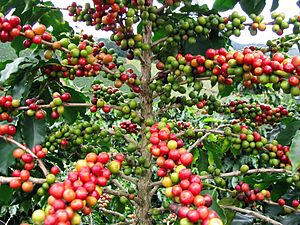
Nicaragua is one of the poorer countries in the Americas. About 48% of its people live below the poverty line. And 79.9% live on less than $2 per day. For indigenous peoples, 80% live on less than $1 per day.
Nicaragua is mainly an agricultural country. Farming makes up 60% of its total exports. This brings in about $300 million each year. Most of the coffee comes from the northern central highlands.
Tobacco has become an important crop since the 1990s. Exports of tobacco and cigars bring in about $200 million per year. Most of Nicaragua's bananas are grown near the port of Corinto. Sugarcane is also grown there. Cassava, a root vegetable, is an important food in tropical areas. It is also used to make tapioca pudding. In the 1990s, the government tried to grow new crops for export. These included peanuts, sesame, melons, and onions.
Fishing boats on the Caribbean side catch shrimp and lobsters. These are processed in towns like Puerto Cabezas and Bluefields. Turtle fishing used to be big on the Caribbean coast. But it stopped because too many turtles were caught.
Mining is growing in Nicaragua. It makes up a small part of the country's economy. Nicaragua's minimum wage is one of the lowest in the Americas and the world. Many rural workers depend on farm jobs, especially in coffee and cotton. Only a few have steady jobs.
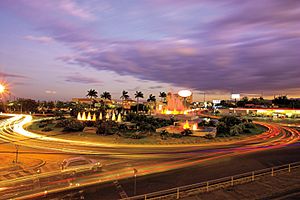
In cities, many people work in the informal sector. These workers include tinsmiths, bakers, shoemakers, and carpenters. They also include people who do laundry or sell food on the streets. Thousands of street vendors and small business owners also work in this sector.
Visiting Nicaragua: A Tourist's Guide
By 2006, tourism became Nicaragua's second largest industry. Each year, about 60,000 U.S. citizens visit Nicaragua. They come for business, tourism, or to see family. About 5,300 people from the U.S. live in Nicaragua. Most tourists come from the U.S., Central or South America, and Europe.
Popular tourist spots include the cities of Masaya and Rivas. Also popular are San Juan del Sur, El Ostional, the Fortress of the Immaculate Conception, Ometepe Island, the Mombacho volcano, and the Corn Islands. Ecotourism, sport fishing, and surfing also bring many visitors.
Nicaragua is called "the land of lakes and volcanoes." This is because of its many lagoons, lakes, and volcanoes. A chain of volcanoes runs along the Pacific side of the country. Today, only 7 of Nicaragua's 50 volcanoes are active. Many volcanoes offer chances for hiking, climbing, camping, and swimming in crater lakes.
The Apoyo Lagoon Natural Reserve was formed by a volcano eruption about 23,000 years ago. This left a huge 7 km-wide crater that filled with water. The lagoon is surrounded by the old crater wall. Restaurants line the rim of the lagoon, many offering kayaks. Besides exploring the forest, many water sports are popular in the lagoon, especially kayaking.
Sand skiing has become popular at the Cerro Negro volcano in León. You can climb both dormant and active volcanoes. Some of the most visited volcanoes are Masaya Volcano, Momotombo, Mombacho, Cosigüina, and Ometepe's Maderas and Concepción.
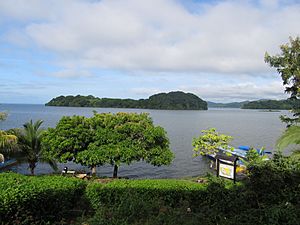
People of Nicaragua
Who Lives in Nicaragua?
A 2014 study showed that 69% of Nicaraguans have mostly European ancestors. 20% have African ancestors, and 11% have Native American ancestors. Another study found that, on average, Nicaraguans are 58–62% European, 28% Native American, and 14% African.
According to the CIA World Factbook, about 69% of Nicaragua's population (5,966,798 in 2016) are mestizo. This means they have mixed European and Indigenous heritage. 17% are white, 5% are Native American, and 9% are black or other races. These numbers can change with migration. About 58% of the population lives in cities.
The capital city, Managua, is the largest. Its population was estimated at 1,042,641 in 2016. In 2005, over 5 million people lived in the Pacific, Central, and North regions. About 700,000 lived in the Caribbean region.
More people from other countries are moving to Nicaragua. Many come from the US, Canada, Taiwan, and European countries. They move for business, investment, or retirement. Most have settled in Managua, Granada, and San Juan del Sur.
Many Nicaraguans live abroad. They are mostly in Costa Rica, the United States, Spain, Canada, and other Central American countries.
Different Ethnic Groups
Most of Nicaragua's people are mestizos, about 69%. About 17% of the population is of pure European descent. Most of these are of Spanish background. Others have German, Italian, English, Turkish, Danish, or French ancestors.
About 9% of Nicaragua's people are black. They mostly live on the country's Caribbean (or Atlantic) coast. This black population is mainly made up of English-speaking Creoles. They are descendants of escaped or shipwrecked enslaved people. Many have names of Scottish settlers who brought enslaved people with them. These names include Campbell, Gordon, and Hodgeson. There are also some Garifuna. These people have mixed West African, Carib, and Arawak heritage.
The remaining 5% of Nicaraguans are Native Americans. They are descendants of the country's original inhabitants. Before Columbus arrived, Nicaragua had many indigenous groups. In the west, there were the Nahua (Pipil-Nicarao) people. Other groups included the Chorotega and Subtiabas. The central region and Caribbean coast were home to indigenous peoples. These groups had moved from South America a long time ago. They include today's Matagalpas, Miskitos, Ramas, and Mayangnas (also known as Sumos). In the 1800s, there was a large indigenous minority. But most of them blended into the mestizo culture.
Languages Spoken
Nicaraguan Spanish has many influences from indigenous languages. It also has some unique features. For example, some Nicaraguans might say /h/ instead of /s/. While Spanish is spoken everywhere, it varies across towns. Vocabulary, accents, and local phrases can be different.
On the Caribbean coast, people speak indigenous languages, English-based creoles, and Spanish. The Miskito language is the most common indigenous language. It is spoken by the Miskito people and some other indigenous and Afro-descendant groups. The indigenous Misumalpan languages of Mayangna and Ulwa are also spoken. Many Miskito, Mayangna, and Ulwa people also speak Miskito Coast Creole. Most of them also speak Spanish.
Fewer than three dozen of nearly 2,000 Rama people speak their Chibchan language well. Almost all Ramas speak Rama Cay Creole. Most also speak Spanish. Experts have tried to record and bring back the Rama language.
The Garifuna people came to Nicaragua from Honduras in the early 1900s. They have recently tried to bring back their Arawakan language. Most of them speak Miskito Coast Creole as their first language. Spanish is their second language. The Creole or Kriol people are descendants of enslaved Africans. They were brought to the Mosquito Coast during British rule. They also have European, Chinese, Arab, and British West Indian ancestors. They speak Miskito Coast Creole as their first language and Spanish as their second.
Culture and Traditions
The Heart of Nicaragua's Culture
Nicaraguan culture has strong traditions in folklore, music, and religion. It is greatly influenced by European culture. But it also includes Native American sounds and flavors.
Nicaraguan culture has different parts. The Pacific coast has strong folklore, music, and religious traditions. These are deeply influenced by Europeans. This area was colonized by Spain. So, its culture is similar to other Spanish-speaking Latin American countries. The indigenous groups who lived on the Pacific coast have mostly blended into the mestizo culture.
The Caribbean coast of Nicaragua was once protected by the British. English is still widely spoken there, along with Spanish and indigenous languages. Its culture is similar to Caribbean nations that were British colonies. These include Jamaica and Belize. Unlike the west coast, the indigenous peoples of the Caribbean coast have kept their distinct identities. Some still speak their native languages as their first language.
Music of Nicaragua
Nicaraguan music is a blend of indigenous and Spanish influences. Musical instruments include the marimba. The Nicaraguan marimba is played by a sitting person holding the instrument on their knees. A bass fiddle, guitar, and guitarrilla (a small guitar) usually play along. This music is often played as background music at social events.
The marimba is made with hardwood plates over bamboo or metal tubes. It is played with two or four hammers. The Caribbean coast of Nicaragua is known for a lively dance music called Palo de Mayo. This music is popular across the country. It is especially loud and celebrated during the Palo de Mayo festival in May. The Garifuna community (who have African and Native American roots) are known for their popular music called Punta.
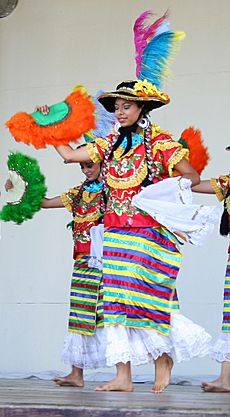
Nicaragua's music scene also has international influences. Bachata, Merengue, Salsa, and Cumbia are popular in cities like Managua and León. Cumbia dancing has grown popular with Nicaraguan artists like Gustavo Leyton.
Dance Styles
Dance in Nicaragua changes depending on the region. In rural areas, dances often focus on hip movements and turns. City dance styles focus more on fancy footwork, along with movement and turns. You can find mixes of styles from the Dominican Republic and the United States. Bachata dancing is very popular in Nicaragua. Many Nicaraguans living abroad, especially in cities like Miami, have influenced Bachata dancing here. Tango has also recently appeared in cultural cities and at ballroom dance events.
Delicious Food
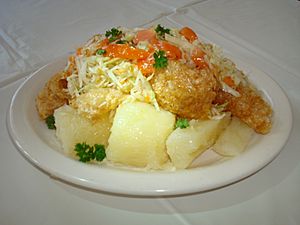
Nicaraguan food mixes Spanish dishes with those from before Columbus arrived. Traditional food changes from the Pacific to the Caribbean coast. The Pacific coast uses local fruits and corn a lot. The Caribbean coast food uses seafood and coconut.
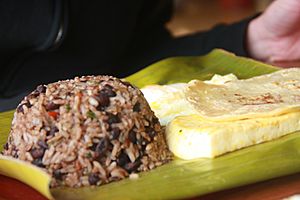
Like in many Latin American countries, maize (corn) is a main food. It is used in many popular dishes, such as the nacatamal and indio viejo. Corn is also an ingredient for drinks like pinolillo and chicha. It is also used in sweets and desserts. Besides corn, rice and beans are eaten very often.
Gallo pinto is Nicaragua's national dish. It is made with white rice and red beans. They are cooked separately, then fried together. There are different ways to make it. On the Caribbean coast, people might add coconut milk or grated coconut. Most Nicaraguans start their day with Gallopinto. It is usually served with carne asada (grilled meat), a salad, fried cheese, and plantains.
Many Nicaraguan dishes include native fruits and vegetables. These include jocote, mango, papaya, tamarindo, banana, and avocado. Herbs like cilantro and oregano are also used.
Traditional street snacks include "quesillo," a thick tortilla with soft cheese and cream. "Tajadas" are deep-fried plantain chips. "Maduros" are sautéed ripe plantains. "Fresco" means fresh juices like hibiscus and tamarind. These are often served in a plastic bag with a straw.
Some Nicaraguans have been known to eat guinea pigs, called cuy. Tapirs, iguanas, turtle eggs, armadillos, and boas are also sometimes eaten. However, efforts are being made to stop this custom. This is because these wild animals are becoming endangered.
Sports in Nicaragua
Baseball is the most popular sport in Nicaragua. Even though some professional teams have stopped playing, the country still loves American-style baseball.
Baseball came to Nicaragua in the 1800s. In 1888, Albert Addlesberg, a retailer from the United States, taught people in Bluefields how to play. Baseball became popular on the Pacific coast in 1891. That's when a group of college students from the U.S. formed "La Sociedad de Recreo" (Society of Recreation). They played many sports, and baseball was the favorite.
Nicaragua has had players in MLB. These include shortstop Everth Cabrera and pitcher Vicente Padilla. But the most famous is Dennis Martínez. He was the first baseball player from Nicaragua to play in MLB. In 1991, he became the first Latin-born pitcher to throw a perfect game. This happened when he played for the Montreal Expos against the Dodgers.
Boxing is the second most popular sport in Nicaragua. The country has had world champions like Alexis Argüello and Ricardo Mayorga. Román González is also a famous boxer. Recently, football has become more popular. The Dennis Martínez National Stadium has been used for both baseball and football. The first stadium just for football in Managua was finished in 2011.
Images for kids
-
An ancient petroglyph on Ometepe Island
-
The Colonial City of Granada near Lake Nicaragua is one of the most visited sites in Central America.
-
Federal Republic of Central America and British colony of the Mosquito Coast in 1830
-
Painting of the Battle of San Jacinto during the Filibuster War.
-
President Anastasio Somoza García (left), with Dominican President Rafael Trujillo, 1952
-
Anastasio Somoza Debayle (center) with Richard Nixon, 1971
-
United States–supported anti-Sandinista "Contra" rebels (ARDE Frente Sur) in 1987
-
Violeta Chamorro in 1990 became the first woman president democratically elected in the Americas.
-
Flooding in Lake Managua after Hurricane Mitch in 1998
-
León Cathedral, one of Nicaragua's World Heritage Sites.
-
Universidad Nacional De Ingeniería "National University of Engineering", Managua
-
Rubén Darío, the founder of the modernismo literary movement in Latin America
See also
 In Spanish: Nicaragua para niños
In Spanish: Nicaragua para niños




